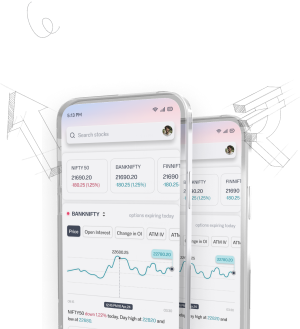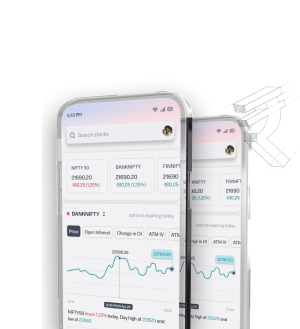Best Intraday Trading Strategies: Systems & Techniques for Successful Intraday Trading
Are you ready to change the way you trade? Let us discuss some intraday trading strategies that can power your trading skills and increase your profit margins by increasing the number of profitable trades. As Indian stock markets are so dynamic—very frequently, many stocks' prices go up or down by 25-35% in a single day—intraday trading is an area for great profits to be made.
Whether you are a beginner or an advanced trader, you will require the best in intraday trading strategies. These help one trade smarter, and you get a confident nudge to do so. It's time to forget those random guesses and move on to strategies that work to take you to success.
Intradays are all about rapid decision-making and risk management to make quick bucks. Tried-and-tested methods increase the possibility of successful trades which enhance your journey in the trading world.
In this article, we will discuss everything, starting from momentum trading to breakout strategies, which are key to success in the changing landscape of trading.
Key Takeaways
Daily fluctuations in the Indian stock markets offer multiple entry points for intraday trading.
- Momentum trading can yield a 2:1 profit-to-loss scenario.
- Through a "Gap and Go" technique, unusual fluctuations in prices of stocks are identified.
- A good breakout market strategy is a potential guide for good entry points to conduct trades.
- Moving average crossovers aid during periods of market trends.
- Success in intraday trading encases the art of making the right decision at the right time—not quick investments.
What is Intraday Trading?
Intraday trading is selling and buying of stock on the same day, with views of price changes within a single working day. Targeted profits come from short-term fluctuations in the price of equities, where a purchase is normally made in the morning and sales done before the close of the market. This type of trade demands constant surveillance of market trends so that a sale can be made based on price changes influenced by news or economic events.
Intraday trading is done on a minute-by-minute or 5-minute or 15-minute chart update, which will enable better say for trading within a day. One of the common strategies is scalping, which is making small profits, but it is making the profits in abundant by a large number of trades. The Volume Weighted Average Price (VWAP) is one such tool that enables understanding the average prices, and thus it becomes easy for the trader to trade profitably during the day.
Types of Intraday Trading
Some of the different methods of intraday trading are:
- Scalping:
- This is a common strategy that involves making small changes in prices through a large number of trades.
- Range Trading
- News-Based Trading
These methods focus on making trades on time, within a day, and ahead of the benefits, there are such as keeping the stop-loss bondage tight, leverage, and acquiring of knowledge from quicker trades. Alongside its benefits, there are equally risks of high commissions and challenges in using methods which will keep the risk consistent.
Benefits of Intraday Trading
| Benefit | Description |
|---|---|
| Elimination of Overnight Risk | At the end of the trading day, all positions are closed, and thus are shielded from the movement of prices in the market. |
| Leverage | The potential returns are always greater because one is able to hold a large position size using just a tiny amount. |
| Multiple Opportunities | Several trades can be opened in the very same day, adding to the aggregate profits. |
| Short Selling | Make money on falling prices, even when you don't actually own the asset: work well in a bear market. |
| Quick Decision Making | Positions are held for less than 6 hours, therefore quick decisions are the essence based on market changes. |
| Risk Management | Proper use of stop-loss and profit targets to control volatility. |
Top Intraday Trading Strategies
Intraday trading success depends on having the right strategies. Let's look at some of the top techniques for confident market navigation, focusing on Moving Average Crossover and Momentum Trading Strategies.
Moving Average Crossover Strategy
The Moving Average Crossover Strategy is most appropriate for novices. The methodology will be to monitor two moving averages: short-term and long-term. The basis arises when the short-term average moves above the long-term average. Similarly, a sell signal is said to have arisen when the short-term average moves below the long-term average. This strategy helps traders identify when to enter and exit trades.
The Momentum Trading Strategy is based on the selection of those stocks that generate strong price movements—above all, those with high momentum upward or downward. Still, successful trades generally offer a risk-reward ratio of 3:1 or better; therefore, this strategy is not for new or even veteran traders who seek to make money fast off tectonic market changes.
| Strategy | Description | Best For |
|---|---|---|
| Moving Average Crossover | Tracks short & long-term moving averages for signals | All Levels |
| Momentum Trading | Focuses on stocks with strong price movements | All Levels |
Additional Intraday Trading Strategies
Choose from the strategies of your choice, according to your risk appetite and trading style, following which you might shine in your career as an intraday trader. Some important popular methods include the following:
| Method Name | Description | Advantages |
|---|---|---|
| Scalping | Repeats small transactions with each price level. | Reduces your exposure and gains quick returns. |
| Reversal Trading | Takes positions against the prevailing trend. | Benefits from unexpected shifts with high return potential. |
| Gap-and-Go | Targets the opening of stocks with a big gap and keep moving. | Provides opportunity to take fast profits. |
Risk Controls in Intraday Trading
Effective risk management is an important factor in ensuring better intraday trading. It protects the investments from potential damage and increases the chance of making a profit. Major components: stop-loss orders, position sizing.
How To Set A Stop Loss
Stop-loss orders are crucial because they help limit the losses. This is because of the automatic selling of the stock once it reaches a specific price level set in advance. For example, when you purchase a stock at ₹500 and set a stop-loss of ₹480, the amount that your loss will be limited to is only ₹20 a share.
Position Sizing
Position sizing will determine how much money you should put into the trade by calculating your risk tolerance. For example, if you have INR 100,000 in your account and do not want to risk more than 2%, then you will figure out your trade size so that you do not risk extremely too much on a single trade.
Importance of Technical Analysis in Intraday Trading
Technical analysis is key in day trading. It uses trading charts and indicators to make informed decisions. Tools like Bollinger Bands and the Relative Strength Index (RSI) help identify the best times to buy and sell.
Key Technical Indicators
| Indicator | Type | Purpose |
|---|---|---|
| Moving Averages | Trend | This gives a hint on whether it is bullish or bearish. |
| Bollinger Bands | Volatility | Analyzes price movement. |
| Relative Strength Index (RSI) | Momentum | Indicating levels of overbought and oversold. |
| MACD | Trend & Momentum | Signaling trade signals and direction of trend. |
| Momentum Oscillators | Trend | Present cycle of trend. |
Effectively used, these indicators assist you in risk management and seeking higher profits, thus enhancing your chances of success with intraday trading.
Effective Entry and Exit Strategies for Intraday Trading
Entry and exit strategies are part of a good trading plan. This is when the two strategies come in, how you decide when to enter and exit trades.
Entry Techniques
Timing really is everything when it comes to the entry methods. Here are some ways to help you:
- Technical Indicators: Moving averages, RSI, or MACD help identity optimal entry points.
- Price Action: from chart analysis, one should watch out for patterns, breakouts, or reversal signals.
- Volume Analysis: As trading volumes pick traction, it could be an indication of great buying interest and entry points to watch out for.
Knowing when to take capital gains or cut losses is every bit as critical as market entry. Here are a few ways in which to determine exit points:
Profit targets: Establish preset goals for getting out of a position to capture profits using a disciplined approach.
Stop-loss orders: This automatically liquidates a trade at a predetermined level of loss in order to protect capital.
- Trailing Stops: Keep profitability so long as the trade goes in your favor, but keep moving the stop level if the price rises.
High Volatility Stocks for Day Trading
Even more important to the success of day trading is the choice of high-volatility stocks. For intraday trading, stocks should own high volatility, generally showing important price variations within the same day.
| Stock Name | Market Cap (Cr) | Share Price (₹) | Volatility (%) | Beeta |
|---|---|---|---|---|
| Adani Enterprises Ltd | ₹3,32,754 | ₹3,268.75 | 75.83 | 1 |
Trading in such stocks enables you to take the benefit of price movements, detecting the winning opportunity during a trading day.
Liquid Stocks for Intraday Trading
Selecting liquid stock is a crucial factor in successful intraday trading. A liquid stock is one which can be readily purchased or sold without aggravating the risk of price change.
For instance, such liquid stocks appropriate for day trading exemplify :
- Vodafone Idea Ltd
- Indian Railway Finance Corp Ltd
- YES BANK Limited
These stocks have low order time and allow the trading order to be executed very fast by entering and exiting a given trade.
Timing the Market for Intra-Day Trading
Timing plays a pivotal role related to the intra-day trading. Knowledge about right trading hours will take you much ahead.
Right Trading Hours
- Trading on Opening: Generally, the market becomes most active within the time span ranging between 9:15 a.m to 9:45 a.m, thereby providing much scope for good traders.
- Post Volatility Trading: Between 10 am to 11:30 am; the market usually cools off a little, which is ideal for making better judgments.
- Quiet Trading Session: Midday hours to around 2:30 pm The market is relatively quiet, thus making it very important to pay attention to news or events that can impact the outcome of your trade.
- Last Hour Bummer: Going into the last hour of trading, between 2:30 pm and 3:30 pm, which can very often be risky because it is close to the market closing hours.
Best Intraday Trading Indicators to Use
Right indicators are very important in day trading. They help to comprehend market events and identify opportunities. Important indicators include:
- Moving Averages
- Bollinger Bands
- Relative Strength Index (RSI)
- MACD
The indication gives the trader the trend in the market and the turning points more explicitly.
Conclusion on Intraday Trading
Mastering intraday trading strategies enhances your trading skills. Some of the effectively-used strategies—such as the strategies for Opening Range Breakouts and those of Bollinger Band —have turned out to be the routes for success in fast-moving markets. Implementing the following can really help you face the challenges of day trading:. Setting close stop-loss orders minimizes losses and entails more possibility of profit by frequent trades.
The key to success in intraday trading is an endless learning curve and adapting to the changing markets. As you do so and become better at it, you will be more comfortable with lasting experiences in this dynamic field.
FAQ
What is intraday trading?
Intraday trading refers to the purchasing and sale of financial instruments the same day.
What benefits can be gained from intraday trading?
numerous opportunities for earning more quite often; the absence of overnight risks, so to speak; the opportunities to get more profits on a chance when the trend is downwards.
What are the best strategies for intraday trading?
Some important strategies also include Moving Average Crossover, Momentum Trading, Scalping, or Reversal Trading. Every strategy for better management amidst changing markets.
How can I manage risk in intraday trading?
Place stop-loss orders to protect capital and use position sizing to not face the scenario when all trading capital is placed at risk in one trade.
Why is technical analysis important in intraday trading?
Technical analysis helps the traders to analyze the pattern of prices and volumes in order to make an informed decision on trading.
What to look at while selecting high-volatility stocks for a day trade?
High-volatility stocks: Select the stocks where the level of volatility is high, indicating large movements in prices, thereby providing numerous opportunities for a trader to earn excess returns. Liquidity along with high levels of volatility in stock will provide the trader with successful trades. Liquid stocks can be easily bought or sold without significantly affecting their prices, hence enabling fast trade execution, which is very necessary for intraday trading.
How important is market timing in intraday trading?
Market timings are very important as these are the times in a day where more activities are done and more opportunities are made available for trading. Knowledge of these times may help increase your trading success.
Disclaimer
The content provided is for educational purposes only and does not constitute financial advice. For full details, refer to the disclaimer document.




